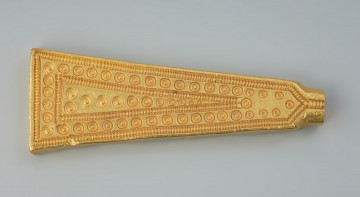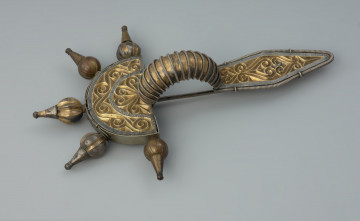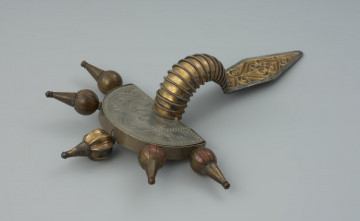
Trapezoidal tile
National Museum in Szczecin
Part of the collection: Antiquity
The gold plate has the form of a symmetrical wedge, which transitions in the narrower end into an oval-shaped base or handle. It is decorated only on the external side with a pseudo-beaded ornament and a motif of concentric circles. In the collection of the Department of Archaeology of the National Museum in Szczecin there are two such nearly identical gold plates from Skalin, found together. Details of the discovery and the context in which they occurred are unknown. All that is known from the archival sources is that both items were found in the 1930s in the gravel pit near Skalin. They can be linked to the Dębczyno group and dated to the 5th century. The Dębczyno group, like most archaeological groups and cultures, is divided into developmental phases. Two phases are distinguished for that group, and the second, later phase, is characterized by its hoars, which included very large, decorated fibulae from precious metals, coins, including Byzantine gold solidi, and other gold objects. The hoard of two gold plates is a characteristic find of the late phase of the Dębczyno group. Analogous items can be identified in the western part of the Baltic Sea basin. Although some researchers consider the find from Skalin to be a hoard, it is possible that the plates actually come from a destroyed grave. Their function is unknown; they could have been fragments of a neck-ring or a bracelet.
Bartłomiej Rogalski
Author / creator
Dimensions
cały obiekt: width: 4.8 cm
Object type
tile
Technique
casting
Material
gold
Creation / finding place
Owner
Muzeum Narodowe w Szczecinie
Identification number
Location / status

National Museum in Szczecin

National Museum in Szczecin

National Museum in Szczecin
DISCOVER this TOPIC
Museum of King Jan III's Palace at Wilanów
DISCOVER this PATH
Educational path